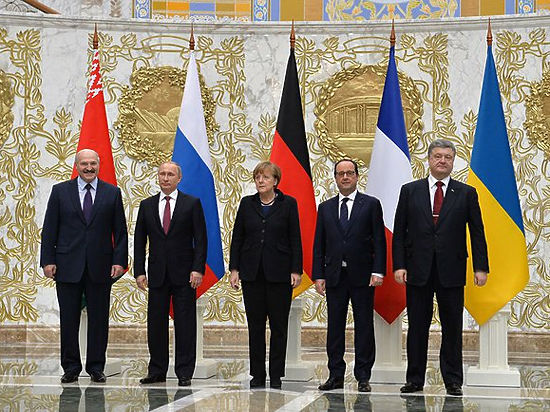In Donetsk, during the night of August 8, four cars belonging to the OSCE mission were set on fire and completely or almost completely destroyed and three armored cars were damaged. These events became headline news for all those involved in the Donbas settlement, and various official comments were made the same day. Those guilty of the arson were condemned by almost everyone -- OSCE Representatives, EU countries, Ukraine's Ministry of Foreign Affairs, Ukraine's president and the secretary of the National Security and Defense Council. Everyone except Russia. So far, Russia has issued no statement on the matter -- not on the web, not even in the Twitter account of the Russian Ministry of Foreign Affairs.
Maria Zakharova, the new spokesperson for the Russian Foreign Ministry, in her August 10 interview with the Vesti news channel following her appointment did not even mention recent events in Donetsk. This was despite the fact that this broadcast devoted almost 15 minutes to another tangential matter -- the international condemnation of the MH17 disaster in 2014.
But we will not use Dmitry Kiselev's (Putin's favorite TV host -- Ed.) methods as weapons ("Coincidence? I don't think so."). There is no clarity. The simplified models do not always help predict the logic of the Russian Federation, and today it is difficult to pinpoint the real reason for the escalation in the Donbas.
There are at least two explanations:
1) These were non-Kremlin-sanctioned actions by the Donetsk terrorists angered by recent reports by the OSCE mission.
2) These were actions coordinated with Russia and designed to squeeze the SMM (Special Monitoring Mission) of the OSCE out of the area of the so-called "DNR" and "LNR" (Donetsk and Luhansk "people's republics").
Presumably events in the coming weeks will provide some clarity and indicate which explanation is correct.
However, there are quite a few indications that the second -- and worse -- option is more likely. The chances are very high that Russia has chosen a tough, but private, opposition to the OSCE presence in the Donbas.
This option is undesirable for Ukraine since it destroys hopes for the de-escalation of the situation in the Donbas. At the same time -- and for the same reasons -- it could have been endorsed by Russian leadership.
Already the DNR is trying to take advantage of the problems of the OSCE mission. The German journalist Julian Röpcke, who is covering events in the Donbas, has drawn attention to the incredible propaganda. On Monday, August 10, DNR announced that 28 civilians had died from shelling despite the fact that during this period the OSCE was present in all the areas of conflict and counted -- no fatalities!
Let us look more carefully at the two scenarios and their possible consequences.
First scenario: OSCE not welcome
First, the worst scenario. The fact that the work of the OSCE has been disliked for some time by the Russians and the "republics" is not a secret. On the basis of SMM findings the world is claiming that the main violators of the truce are precisely the pro-Russian militants.
At present Russia is gradually losing the PR fight with the world and there is no doubt that in Moscow they want to change the current situation. There are two ways to do that: by generating positive news on how much Russia desires peace or else by putting a stop to the stream of negative news.
The positive scenario is not working out. The economy of the Donbas is not "rising from its knees" and the chances for its recovery are close to zero. There is no progress in implementing the Minsk agreements and few believe that this will change. Each week there is new evidence on Russian involvement in the invasion of the Donbas. As a result, in Europe and the US there are more and more arguments in favor of extending the sanctions. Therefore,the Kremlin has at its disposal only the "negative" scenario.
Where does all the news about "Minsk" violations originate? With the OSCE. Therefore, it is necessary to arrange for this organization's monitoring mission to stop reporting problems or else for it to leave "LNR" and "DNR." However, Russia needs to "expel" it carefully to avoid being held responsible.
Therefore, the SMM must make the decision to withdraw from Donetsk and Luhansk on its own. And, according to this scheme, the assignment of Russians and their "DNR" and "LNR" partners is to create intolerable conditions for the OSCE under which it will have no other option than to stop the monitoring mission.
This is what appears to be happening now. And even this mission, which has always weighed all public statements very carefully, is claiming there are attempts to silence it. A statement issued by the SMM OSCE admits the possibility that "there are those who want the OSCE to cease reporting about what is happening in Donetsk," concluding that "there are some who believe that violent attacks on the civilian population and their property are a justifiable means to achieve this goal." The organization has also placed responsibility for protecting the property and safety of the mission on "those who control the situation in Donetsk"
Moscow's traces?
At the same time, the question remains if it is possible to argue that Moscow or even the official DNR "leadership" is involved in putting pressure on the OSCE. So far, we can speak exclusively about circumstantial evidence, which includes the previously mentioned silence of Moscow regarding the burning of the SMM cars.
The fact that similar protests have taken place in Donetsk and Luhansk support the argument that the pressure was planned and coordinated. As is known, DNR and LNR are separate entities that are not especially friendly and whose only common denominator is their link with Moscow. However, in recent days -- on August 6, in Donetsk, and August 9, in Luhansk, street protests took place near the SMM bases there. Participants did not engage in discussions with the mission but demanded that it change its attitude to events in the Donbas.
Diplomats who spoke with European Pravda on condition of anonymity say the mission monitors are also increasingly confronted with harsh actions by the militants while on the road.
"This has already become a standard scenario: the mission arrives at an 'undesirable' location, shots are heard in the air (not necessarily from small arms -- it can also be mortar fire), and, according to their instructions, the monitors are forced to leave the area," the source says.
However, this "tool" cannot be used too extensively since all instances when the OSCE is refused entry or cases where it has to leave the scene of activity end up in the mission's reports and serve as evidence against the militants. This is exactly why, as the OSCE itself recognizes, that DNR wants the mission to be silenced altogether.
Officially, the SMM is giving assurances that it is continuing its activities as before. However, the mission's daily reports indicate that OSCE representatives have reduced their visits to the occupied territories to a minimum.
Here are the simple facts: the OSCE report for August 6, lists seven episodes when monitors witnessed abnormal events in territories controlled by the terrorists or when they were prevented from entering certain areas. The report for August 7, lists ten such episodes.
But on Sunday, August 9, despite increased skirmishes in the ATO zone, the report for the weekend was almost empty. Most of the data was for Saturday or was not dated at all. Only two episodes were dated for Sunday, August 9 -- both in the Luhansk Oblast.
It is likely that after the burning of the cars the SMM representatives were instructed not to move at all, even in the Donetsk territory. How long this limitation remains in effect will become clear from subsequent reports.
Second version: actions without Moscow's knowledge
Let us return to the question of the real "client" for the burning of the mission's cars.
Ukrainian diplomatic sources are in no hurry to state categorically that this development is according to a Moscow scenario. However, they view the first version of events as more likely. Thus, on Monday evening, August 10, the Ministry of Foreign Affairs of Ukraine said that Foreign Minister Pavlo Klimkin in a conversation with Russia's Foreign Minister Sergey Lavrov "called on Russia to reconsider."
According to one source, "this (burning of OSCE cars on Moscow's instructions) is quite possible but not proven. The issue is that these 'cranks' from the 'people's republics' are not fully controlled by the Kremlin. It is not the army. There really is a lot of independent activity there -- even against Moscow's wishes," he said.
"It is not out of the question that this is 'DNR/LNR' revenge for the critical items in the recent reports. This revenge -- whether or not approved by Moscow -- is not intended to finally squeeze out the SMM OSCE from the Donbas," another source added.
The revenge thesis is not unreasonable since the mission's recent reports must have unnerved even Moscow and the terrorist "leadership." Since the beginning of August, the OSCE monitors have finally acknowledged officially what the world has known for over a year.
On August 1, the SMM report stated for the first time that the militants have been shelling Ukrainian positions from residential areas of Donetsk (even though social networks have been posting numerous videos confirming that fact). And on August 7, the mission reported seeing persons who identified themselves as Russian military in the occupied territories.
In this case, the silence of the Ministry of Foreign Affairs of the Russian Federation regarding the burning of the OSCE cars can be explained by the fact that they do not know how to react to events that happened without their knowledge. But this uncertainty will not last long. Already in the near future negotiations of the "Normandy Four" (Germany, France, Russia, Ukraine -- Ed.) may take place as a result of the new escalation in the Donbas. And on Monday night Klimkin was discussing that possibility with the foreign ministers of France and Germany.
And though no one expects that during such a meeting (if it takes place) the Russians will assume responsibility for the burning of the cars, it will become obvious if they are willing to stop the new escalation of the conflict.
Otherwise, the world will see clearly who is behind the events surrounding the OSCE mission.





